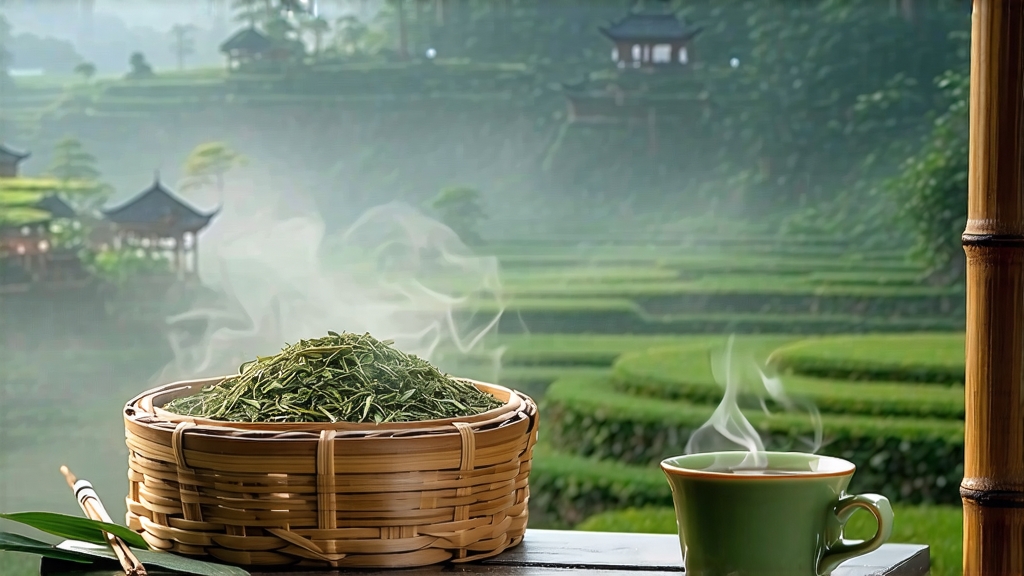
Few Chinese teas have crossed cultural borders as gracefully as Tie Guan Yin, the “Iron Goddess of Mercy.” Named after the Bodhisattva Avalokitesvara, this oolong from southern Fujian’s Anxi County carries both spiritual poetry and technical brilliance in every leaf. To understand China’s vast oolong family, start here: where green freshness meets roasted depth, where dynastic legends intertwine with modern biotech labs, and where a single cultivar can taste like spring orchids or toasted brioche depending on the hand that finishes it.
Historical roots
Anecdotes place Tie Guan Yin’s birth anywhere from the 1720s to the 1730s, when a devout farmer named Wei Yin allegedly found an iron statue of the Goddess near a scraggly tea bush in Yaoyang Village. After praying and tending the plant, he discovered its liquor unusually fragrant. Imperial records from the Yongzheng reign already list “Ti Kuan Yin” as tribute tea, so the cultivar clearly seduced court palates within one generation. Overseas, the tea reached British cups by the 1850s, shipped through Xiamen’s bustling port; Edwardian London tea auctions sometimes priced it higher than first-flush Darjeeling. In the late 1990s, Taiwanese tea makers returned to Anxi with new light-oxidation techniques, igniting the modern “qing xiang” (fresh aroma) craze that now dominates domestic e-commerce.
Cultivar and terror
True Tie Guan Yin comes only from the Camellia sinensis var. sinensis cultivar “Tie Guan Yin,” a medium-leaf bush with serrated edges that blush bronze under strong UV. Anxi’s granite mountains, 500–800 m elevation, and subtropical monsoon climate create the classic “three yellows, seven greens” leaf coloration. Diurnal swings of 10 °C lock in floral volatiles—linalool, geraniol, indole—while iron-rich lateritic soils lend a subtle mineral bite. Attempts to transplant the cultivar to Yunnan or Vietnam succeed agronomically yet lose the hallmark “rock-orchid” note, proving that Tie Guan Yin is as site-specific as Burgundy’s Pinot Noir.
Processing choreography
Unlike green tea that seeks to halt oxidation or black tea that pursues full oxidation, Tie Guan Yin pirouettes in the 20–50 % range. The dance begins in the cool of evening: leaves are shaken in bamboo drums to bruise epidermal cells, then sun-withered for 30–40 minutes until they lose the “green” bite. Oxidation continues on rattan trays in air-conditioned rooms kept at 23 °C and 75 % humidity. Masters judge readiness by nose—when the grassy top-note folds into peach skin and gardenia, firing in 280 °C drum roasters stops the clock. Modern “qing xiang” versions are quickly vacuum-cooled, whereas the traditional “nong xiang” style undergoes an extra 60 °C bake for 4–6 hours, building chestnut and caramel tones. Final stem-picking is done by tweezers, leaving only the apical bud and two adjacent leaves, ensuring visual symmetry and even extraction.
Styles and grades
- Qing Xiang (Light Aroma): pale jade liquor, snap-pea sweetness, orchid bouquet; best within six months of production.
- Nong Xiang (Roasted Aroma): amber cup, honeyed fig, toasted sesame; ages gracefully, acquiring raisin depth after two years.
- Chen Xiang (Aged): re-roasted every 24 months, stored in unglazed clay jars; 1998 vintages taste of date, sandalwood, and antique paper.
- Zheng Wei (Original Flavor): a middle road—moderate bake, lingering milkiness, the choice of Anxi locals for daily gongfu.
Grading follows leaf integrity, aroma intensity, and infusion endurance. “Super A” demands seven brews still fragrant, with uniform 2 cm leaf fragments and no red edges (a sign of over-oxidation).
Brewing science
Water: 95 °C for light aroma, 100 °C for roasted; TDS 30–50 ppm soft water amplifies florals.
Ratio: 1 g leaf per 15 ml vessel; a 120 ml gaiwan needs 8 g.
Rinse: 3-second flash to open leaf pores, discard.
Timing: 1